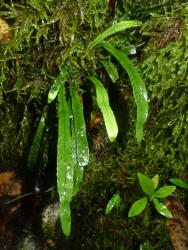Terrestrial, rupestral or epiphytic ferns. Rhizomes erect, or short- to long-creeping and very thin, not pruinose, scaly. Rhizome scales non-clathrate or rarely partially clathrate, ovate or narrowly ovate, pale to medium brown or rarely bicolorous with dark brown centres. Fronds monomorphic, not or rarely articulated to rhizome. Stipes glabrous or bearing non-glandular hairs or setae. Laminae entire to 2‑pinnatifid, herbaceous or coriaceous, glabrous or bearing non-glandular hairs. Veins free; hydathodes present or absent. Sori round or elongate along veins, superficial or slightly sunken into lamina surface, in one row either side of costa or midrib; paraphyses present or absent; exindusiate. Spores monolete; perispores granulate and papillate, chlorophyllous.
A genus of 12 species (Perrie & Parris 2012).
Phylogenetic analysis of chloroplast DNA sequences in grammitid ferns by Ranker et al. (2004) demonstrated a need for considerable realignment of generic boundaries within the grammitid ferns. Several new grammitid genera have since been described (Sundue et al. 2014).
In his monographic study of Grammitis, Copeland (1951) recognised just three species in New Zealand: G. billardierei, G. ciliata and G. crassa. Allan (1961) extended this to five species, with the addition of G. pumila and G. heterophylla, although Tindale (1961) separated the latter into Ctenopteris on the basis of its pinnately divided fronds. Parris & Given (1976) revised Grammitis in New Zealand, recognising a total of nine species and two subspecies in the region, in addition to Ctenopteris heterophylla. Parris (1998) subsequently added the Tasmanian G. gunnii to the New Zealand flora. However, Ranker et al. (2004) demonstrated that Ctenopteris and Grammitis were not monophyletic when defined on the basis of frond dissection. Since then, based on phylogenetic analysis of chloroplast DNA sequences, Perrie & Parris (2012) have shown that all 11 New Zealand grammitids, together with one Tasmanian species, form a single clade, which they recognised as Notogrammitis and which includes all grammitid species occurring below 35º 30’ S worldwide. The recognition of a new genus has had nomenclatural consequences for several traditionally recognised species, detailed in the synonymies and Notes below.
| 1 | Fronds 1–2-pinnatifid | heterophylla |
| Fronds entire | 2 | |
| 2 | Hairs present in and around the sori | 3 |
| Hairs absent from the soral area | 7 | |
| 3 | Rhizomes long-creeping | 4 |
| Rhizomes erect or short-creeping | 5 | |
| 4 | Laminae 6–160 mm long; stipe and lamina hairs dark red-brown; soral hairs up to 3 mm long | patagonica |
| Laminae 8–70 mm long; stipe and lamina hairs white to pale brown; soral hairs up to 1.5 mm long | gunnii | |
| 5 | Soral hairs dark red-brown, stout | rawlingsii |
| Soral hairs pale brown or whitish, slender | 6 | |
| 6 | Laminae 1.5–6 (–8) mm wide, 9–80 (–100) mm long; lamina margins entire and flat; hydathodes usually absent, rarely present; plants rupestral or terrestrial | ciliata |
| Laminae 3–12 mm wide, 22–165 mm long; lamina margins often scalloped and undulate; hydathodes present; plants epiphytic | pseudociliata | |
| 7 | Laminae 9–20 mm wide; rhizome scales >8 mm long | rigida |
| Laminae usually <10 mm wide; rhizome scales <6 mm long | 8 | |
| 8 | Stipes hairy; hairs present as setae*, or hairs branched with setiform branches | 9 |
| Stipes glabrous, or with simple catenate hairs* | 10 | |
| 9 | Rhizomes short- to long-creeping; stipes clearly defined, not winged; fronds 9–115 mm long; sori in 1–10 pairs | givenii |
| Rhizomes erect to short-creeping; stipes usually ill-defined, winged; fronds 20–245 mm long; sori in 1–36 pairs | billardierei | |
| 10 | Rhizomes erect to short-creeping; sori usually in >10 pairs; plants usually epiphytic | angustifolia |
| Rhizomes short- to long-creeping; sori in <10 pairs; plants terrestrial or rupestral | 11 | |
| 11 | Fronds 4–42 mm long; sori in 1–5 (–7) pairs | crassior |
| Fronds 9–115 mm long; sori in 1–10 pairs | givenii |
*Setae are tapered at the apices and appear unicellular; catenate hairs are clearly multicellular, with adjacent cells collapsed at right angles to each other.
Species of Notogrammitis are mostly small epiphytic or rupestral ferns, with erect to long-creeping rhizomes, usually undivided laminae, free veins, sori round or elongated along veins and lacking indusia. Spores are characteristically chlorophyllous and granulate (Large & Braggins 1991).
Notogrammitis is confined to southern temperate regions, extending southwards from 28º S, and is the only grammitid genus below 35º 30’ S. Its centre of diversity is in Australia and New Zealand, but species are also present in Chile, Argentina, South Africa and many of the islands of the Southern Ocean (Perrie & Parris 2012). Three species in South America, one in South Africa, seven in Australia. Eleven species in New Zealand; four endemic and seven indigenous.
| Category | Number |
|---|---|
| Indigenous (Endemic) | 4 |
| Indigenous (Non-endemic) | 7 |
| Total | 11 |
Notogrammitis has a base chromosome number of x = 37 (Dawson et al. 2000; Tindale & Roy 2002).




